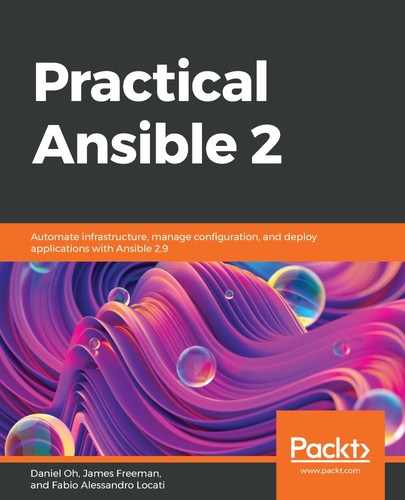Chapter 1, Getting Started with Ansible, provides the steps you need for your very first installation of Ansible, and explains how to get up and running with this powerful automation.
Chapter 2, Understanding the Fundamentals of Ansible, explores the Ansible framework, gives you a sound understanding of the fundamentals of the Ansible language, and explains how to work with the various command-line tools that it comprises.
Chapter 3, Defining Your Inventory, gives you details about the Ansible inventory, its purpose, and how to create your own inventories and work with them. It also explores the differences between static and dynamic inventories, and when to leverage each type.
Chapter 4, Playbooks and Roles, provides you with an in-depth look at creating your own automation code in Ansible in the form of playbooks, and how to enable effective reuse of that code through roles.
Chapter 5, Consuming and Creating Modules, teaches you about Ansible modules and their purpose, and then provides you with the steps required to write your own module, and even to submit it to the Ansible project for inclusion.
Chapter 6, Consuming and Creating Plugins, explains the purpose of Ansible plugins, and covers the various types of plugin that Ansible uses. It then explains how to write your own plugins, and explains how to submit your code to the Ansible project.
Chapter 7, Coding Best Practices, provides an in-depth look at the best practices that you should adhere to while writing Ansible automation code to ensure that your solutions are manageable, easy to maintain, and easy to scale.
Chapter 8, Advanced Ansible Topics, explores some of the more advanced Ansible options and language directives, which are valuable in scenarios such as performing a roll-out to a highly available cluster. It also explains how to work with jump hosts to automate tasks on secure networks, and how to encrypt your variable data at rest.
Chapter 9, Network Automation with Ansible, provides a detailed look at the importance of network automation, explains why Ansible is especially well suited to this task, and takes you through practical examples of how to connect to a variety of network devices with Ansible.
Chapter 10, Container and Cloud Management, explores the manner in which Ansible supports working with both cloud and container platforms, and teaches you how to build containers with Ansible, along with methods to deploy infrastructure as code in a cloud environment using Ansible.
Chapter 11, Troubleshooting and Testing Strategies, teaches you how to test and debug your Ansible code, and gives you robust strategies to handle errors and unexpected failures both with playbooks and the agentless connections on which Ansible relies.
Chapter 12, Getting Started with Ansible Tower, provides an introduction to Ansible Tower and its upstream open source counterpart, AWX, demonstrating how this powerful tool provides a valuable complement to Ansible, especially in large, multi-user environments such as enterprises.
